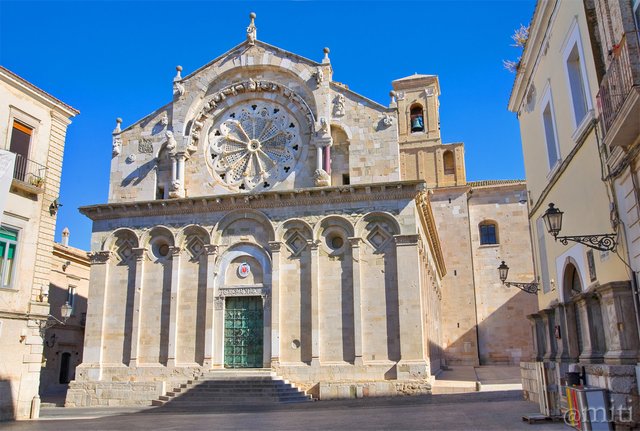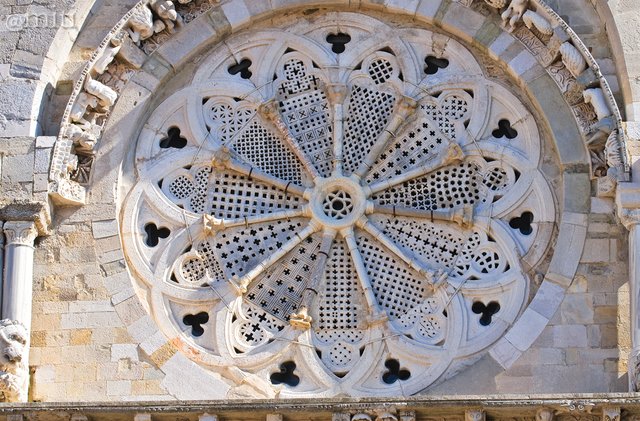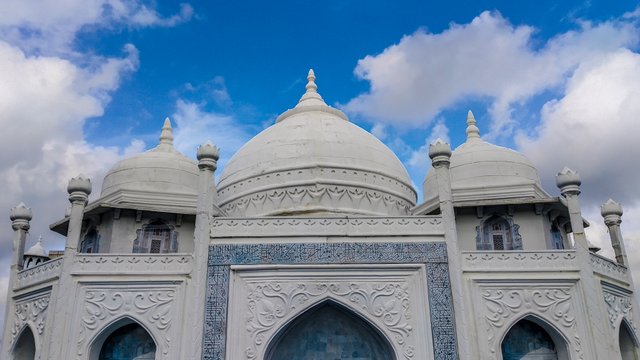A Journey through Italy: one photo every day #137 - TROIA [ENG/ITA]

The Cathedral of the Assumption into Heaven of the Blessed Virgin Mary (Author's photo - All rights reserved)
La Cattedrale della Beata Vergine Maria Assunta in Cielo (Immagine dell'autore - tutti i diritti sono riservati)



Ciao a tutti,
questo è un viaggio attraverso l'Italia. Posterò una foto al giorno con una brevissima descrizione. Spero vi piaccia!

Troia è una piccolo borgo della provincia di Foggia, nella regione italiana meridionale della Puglia. Si trova sulle prime alture dell'Appennino Dauniao in posizione dominante sull'intero altopiano del Tavoliere.
Il villaggio di Troia ha origini antiche. Secondo la leggenda, fu fondata nel XII-XI secolo a.C. al tempo dell'eroe greco Diomede che, insieme ad Ulisse, conquistò la città di Troia in Asia Minore.
Alcuni ritrovamenti fanno risalire il centro alla prima età alle guerre puniche. Prima di essere colonizzata dai Romani, la città era conosciuta come Aika, successivamente latinizzata in Aecae.
L'attuale villaggio nacque nel 1019. Troia, infatti, fu ufficialmente fondata per diventare una roccaforte dell'impero bizantino. Si potrebbe dedurre da un'incisione in latino sulla porta di bronzo detta della libertà, posta sul lato destro della cattedrale, forgiata nel 1127, 108 anni dopo la fondazione di Troia.
La città si schierò prima con gli Angioini, poi con gli Aragonesi e più recentemente con i Borboni, a cui rimase fedele fino al collasso della loro monarchia. Il nome di Troia è indissolubilmente legato alla storia, come nello stemma originale della città nel quale capeggia una scrofa, intenta ad allattare sette porcellini.
I principali punti di interesse del borgo di Troia sono costituiti dalla Cattedrale, il Museo Diocesano e il Museo Civico, l'edificio Municipale o Palazzo Avalos (con il fantasma del marchese) e la Chiesa di San Basilio Magno.
La Cattedrale Romanico-pugliese della Beata Vergine Maria Assunta in Cielo, costruita su due piani, è l'orgoglio dell'elegante centro storico e il simbolo magico della città. Il gioiello architettonico dell'edificio è l'affascinante rosone trecentesco, un meraviglioso ricamo in pietra, unico al mondo, con undici segmenti divisi da altrettanti montanti e trafori, ciascuno diverso dall'altro. Il bel rosone è sostenuto da un portale bronzeo, decorato con storie di santi e vescovi.
Considerato il più antico luogo di culto di Troia, la chiesa di San Basilio è stata menzionata in una pergamena di Montecassino nel 1087. La facciata conserva il portale originale, così come la bifora e due fregi, mentre sul lato sinistro sono due porte decorate, una delle quali sormontata da un architrave romano. L'interno, a croce latina, è scandito da otto colonne che terminano in capitelli con semplici foglie angolari.
Il Palazzo del principe D'Avalos è un edificio del 16 ° secolo, ristrutturato e ampliato nel 1643 da Francesco D'Avalos, principe di Troia. E 'stato ristrutturato di nuovo nel XX secolo e oggi è sede del Municipio e del Museo Civico. Il complesso è costituito da un cortile interno dove sorgono diverse stanze ora adibite a uffici.
Grazie alla bellezza del suo centro storico, Troia ha ricevuto la Bandiera Arancione (un premio assegnato ai borghi più belli) del Touring Club Italiano.
Cosa vedere: il centro storico, la cattedrale della Beata Vergine Maria Assunta in Cielo, il palazzo del Principe D'Avalos, la chiesa di San Basilio, il convento di San Benedetto, la chiesa di San Francesco, la Chiesa di Maria SS. Mediatrice, il Museo del tesoro della Cattedrale, il Museo Diocesano, il Museo Civico.

Hello everyone,
I began a Photo Journey through Italy. I will post one photo every day with a little note of explanation. I hope you like it!

Troia is a small town in the province of Foggia, in the southern Italian region of Puglia. It is located on the first hills of the Daunia Apennines in a domineering position over the whole Tavoliere plateau.
The village of Troia has ancient origins. According to the legend, was founded in the XII-XI century B.C. at the time of the Greek hero Diomedes who, together with Ulysses, conquered the city of Troy in Asia Minor.
Some findings date back the center to front age to the punic wars. Before being colonized by the Romans, the town was known as Aika, subsequently Latinized into Aecae.
The present village was born in 1019. Troia, indeed he was officially founded to become a stronghold of the Byzantine Empire. It could be deduced from an incision in Latin on the bronze door said of freedom, placed on the right side of the Cathedral, forged in 1127, 108 years after the foundation of Troy.
The city is lined first with the Angevins, then with the Aragonese and more recently with the Bourbons, to which he remained faithful until the collapse of their monarchy. The name of Troy is inextricably linked to the history, as in the original coat of arms of the city was shown a sow, intent to breastfeed seven piglets.
The main points of interest in the village of Troia are constituted by its Cathedral, the Diocesan Museum and the Civic Museum, the Town Hall building or Avalos Palace (with the ghost of the marquis) and the Church of San Basilio Magno.
The Apulian - Romanesque Cathedral of Santa Maria dell’Assunta, built on two floors, is the pride of the elegant historic centre and the magic symbol of the town. The architectural gem of the building is the fascinating thirteenth-century rose window, a wonderful stone embroidery, unique in the world, featuring eleven segments divided by as many mullions and tracery, each one different from the other. The beautiful rose window is sustained by a bronze portal, decorated with stories of saints and bishops.
Considered to be oldest worship place in Troia, the Church of St. Basilius was mentioned in a parchment of Montecassino in 1087. The façade preserves the original portal, as well as the double-lancet window and two friezes, while on the left side are two decorated doors, one of which topped by a Roman lintel. The interior, on a Latin cross plan, is punctuated by eight columns ending in capitals with simple angular leaves.
The Palace of prince D'Avalos is a building of the 16th century, restructured and enlarged in 1643 by Francesco D’Avalos, prince of Troia. It was restructured again during the 20th century and nowadays it is the seat of the Town Hall and of Museo Civico (Town Museum). The complex consists of an internal courtyard where stand several rooms now used as offices.
Thanks to the beauty of its historic centre, it has been awarded the Orange Flag (a prize awarded to the most beautiful hamlets) of the Italian Touring Club.
Thing to see: the Historical centre, the Cathedral of the Assumption into Heaven of the Blessed Virgin Mary, the Palace of prince D'Avalos, the Church of Saint Basilius, the Saint Benedict’s Convent, the Church of Saint Francis, the Church of Our Blessed Lady Mediatrix, the Museum of the treasure of the cathedral, the Diocesan Museum, the Civic Museum.

| Tipo di foto / Category | Paesaggio / Landscape view |
| Esposizione / Settings | 1/250 sec, ISO 200, f/10 |
| Camera | Nikon D5000 |
| Lente / Lens | Tamron SP 17-50mm f/2.8 XR Di II LD |
| Filtro / Filter | Polarizzatore Hoya / Hoya Polarizing filter |
| Cavalletto / Tripod | Manfrotto MKC3-P01 |
| Località / Location | Troia (Foggia), Italia |
| Software | Photoshop |


The Cathedral of the Assumption into Heaven of the Blessed Virgin Mary (Author's photo - All rights reserved)
La Cattedrale della Beata Vergine Maria Assunta in Cielo (Immagine dell'autore - tutti i diritti sono riservati)
After looking the pictures of Italy I wish to visit this place soon...
I hope you do! We're a very friendly people.
best posts
Congratulations, Your Post Has Been Added To The Steemit Worldmap!
Author link: http://steemitworldmap.com?author=miti
Post link: http://steemitworldmap.com?post=a-journey-through-italy-one-photo-every-day-137-troia-eng-ita
Want to have your post on the map too?
awesome capture ,i do have something similar like this , checkout mine that i post here
Beautifultooo waiting for next one @miti
Thanks.
Amazing architecture. You surely have a wealth of sun-drenched days for your photographic outings.
Here in the south of Italy, the weather's always good in summer time!
I love Italy 💖
Happy to hear that!
Beautiful piece of architect
Posted using Partiko Android
Yes, very impressive!
Forte questa architettura :-)))
Dovresti vederla dal vivo.. anche i suoi interni. Rimarresti a bocca aperta!
Immagino..... :-)))
I love italian architecture!! regards buddy!